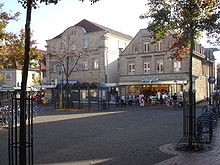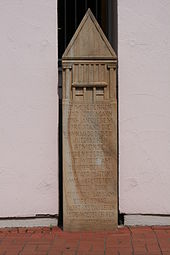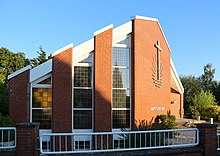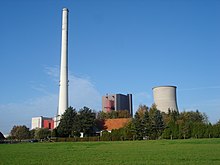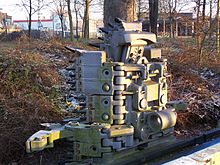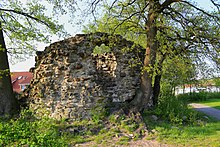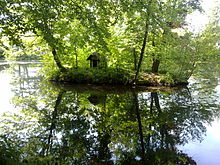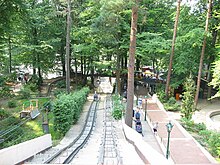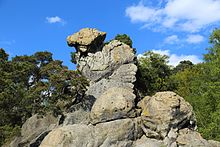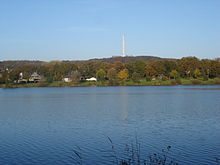Ibbenbueren
| coat of arms | Germany map | |
|---|---|---|

|
Coordinates: 52 ° 17 ' N , 7 ° 43' E |
|
| Basic data | ||
| State : | North Rhine-Westphalia | |
| Administrative region : | Muenster | |
| Circle : | Steinfurt | |
| Height : | 70 m above sea level NHN | |
| Area : | 108.87 km 2 | |
| Residents: | 51,822 (Dec. 31, 2019) | |
| Population density : | 476 inhabitants per km 2 | |
| Postcodes : | 49477, 49479 | |
| Primaries : | 05451, 05455 , 05456, 05459 | |
| License plate : | ST, BF, TE | |
| Community key : | 05 5 66 028 | |
| LOCODE : | DE IBB | |
| City structure: | 9 districts | |
City administration address : |
Alte Münsterstrasse 16 49477 Ibbenbüren |
|
| Website : | ||
| Mayor : | Marc Schrameyer ( SPD ) | |
| Location of the city of Ibbenbüren in the Steinfurt district | ||
The former mining town of Ibbenbüren ( Ippenbürn in Low German ) is a medium- sized town and the largest city in the Westphalian region of Tecklenburger Land and, after Rheine, the second largest in the Steinfurt district in North Rhine-Westphalia . Ibbenbüren gained national fame through its coal mining and as a power station location.
geography
The city, through which the Ibbenbürener Aa flows, is located at the northwest end of the Teutoburg Forest between Rheine in the west and Osnabrück in the east, which are each about 20 kilometers away. In the north of Ibbenbüren lies the Ibbenbürener Bergplatte with the Schaf- und Dickenberg, from which the tarpaulin flowed through the inner city of Ibbenbüren until 1859 . The mean altitude is 70 m above sea level. NHN .
City structure
Ibbenbüren is divided into nine districts , sorted by number of inhabitants (as of June 30, 2020) these are:
| district | Residents | Change (since March 31, 2020) |
|---|---|---|
| Downtown | 24,055 | - 81 |
| Laggenbeck / Osterledde | 9,565 | + 7 |
| Püsselbüren | 4,919 | - 37 |
| Fixed wheels | 4,608 | - 16 |
| Alstedde / Schafberg | 3,941 | - 19th |
| Dickenberg | 3,263 | ± 0 |
| Dörenthe | 1,411 | - 7th |
| Fiefdom / Schierloh | 1,355 | - 15 |
| Uffels | 790 | + 3 |

Neighboring communities
The urban area borders on a total of seven cities and municipalities. Ibbenbüren is almost exclusively surrounded by municipalities in the Tecklenburger Land. The municipality of Saerbeck is already located in the Münsterland in the southwest.
|
Hopsten 14 km |
Stretch 10 km |
Mettingen 6 km |
|
Hörstel 9 km |

|
Westerkappeln 12 km |
|
Saerbeck 13 km |
Tecklenburg 12 km |
Urban development
With the continuous population growth in the last decades, Ibbenbüren has expanded in terms of urban development. Two main development axes can be identified:
- To the west
The third, new motorway junction in Ibbenbürener urban area in Schierloh and the designation of a new industrial area are intended to drive further urban development towards the west. A further expansion is created by the designation of new residential areas in the direction of Püsselbüren .
- Direction east / south-east
Due to the expansion of the inner city towards the east and the simultaneous expansion of the Laggenbeck district towards the west, the buildings are slowly moving towards each other. Although the official distance between the inner city border and Laggenbeck on the connecting roads is five kilometers, under urban planning aspects it has already dropped to around two kilometers.
Legally, Ibbenbüren is a middle district town according to § 4 Abs. 2 of the municipality code NRW (GO NRW) . According to the 2007 reform of the municipal code (Section 4 (3) GO NRW), the city is authorized to apply to the state for the status of a large city belonging to a district. This would transfer further powers of the district to the city.
history
Derivation of the city name
The basic word -büren is derived from Niederdtsch. -büren, -bur (en) and comes from Old High German as bur for "small house" etc., central Netherlands. buur for "apartment, village".
The origin of the defining word is not clearly clarified: Dieter Berger ( Duden ) sees it as a proper name, which should mean "the houses of Ibbo". Even Ernst Förstemann ( Old German name book - place names) regards it as a personal name of the tribe IB and the nickname leads Ibba (commander of Theodoric d Great.) And Ibbon ( Bishop of Tours on). According to Hermann Abels, the defining word ibben can on the one hand derive from ibe = berry-bearing tree, yew . derive; from Germ. -ihwa , cf. old high German. iwa , old north. ýr , gall. iwos , lett. ive ; the yew tree was seen as a direct link to the earth goddess. This derivation describes a place for hunting magic . On the other hand, the meaning ibe / iwe = arch is possible; Middle High German iwe = bow, Swabian aib = crossbow. Arch has been made of yew wood since the Stone Age. A meeting place is described here in a circle.
middle Ages
Ibbenbüren was first mentioned in a document on April 14, 1146, when the then bishop of Osnabrück, Philipp von Katzenelnbogen , gave the Osnabrück Gertrudenkloster part of the tax revenue from Ibbenbüren ("the tenth of the people in the huts in Hibbenburen"). Although Ibbenbüren is much older and a document from 1348 shows that a church was founded in 799, 1146 is officially the year Ibbenbüren was founded. In the years 1219 and 1234 it appears as a church village . During this transition from the High Middle Ages to the Late Middle Ages , the noblemen of Ibbenbüren, the abbess of Herford and the counts of Tecklenburg owned manors in the village. At that time Ibbenbüren belonged to the Diocese of Osnabrück . During this time Ibbenbüren Castle was built by the noblemen of Ibbenbüren from 1150. The last remnants of this castle are the remains of the Heidenturm near the Ibbenbüren Aasee .
After the lords of Ibbenbüren died out, the place came under the sole rule of the Counts of Tecklenburg . This rule lasted until the end of the 15th century.
Early modern age
In 1493 Ibbenbüren and the County of Lingen were split off from the County of Tecklenburg . Count Konrad von Tecklenburg-Schwerin was able to reunite the two counties in 1541. However, Ibbenbüren finally fell into the possession of Emperor Charles V in 1548 through clumsy and hapless tactics of the Count of Tecklenburg with the County of Lingen , who gave it to his sister Maria , the governor of the Netherlands. During this period, hard coal production in Ibbenbüren also began.
Ibbenbüren, which came under the control of the Netherlands and Spain after several changes during the Eighty Years War , came to the House of Orange in 1648 after the Peace of Westphalia . In 1674 the Catholics had to give their church, today's Christ Church, to the Protestant community. With effect from March 6, 1675, the Orange rulers forbade the celebration of Catholic services.
In the 17th century, the mining of iron ore began in and around Ibbenbüren, the extraction of which was to continue into the first half of the 20th century. As part of the succession, Ibbenbüren came under Prussian rule in 1702 . On February 1, 1724 Ibbenbüren obtained city rights, which was, among other things, in connection with the introduction of the excise duty . In 1743 the first magistrate and mayor was appointed.
19th century
During Napoleon's reign at the beginning of the 19th century, Ibbenbüren belonged to the Grand Duchy of Berg (1806) later to the French Empire ( department of the Upper Ems ) until it was captured by Prussian and Russian troops in 1815 and placed under Prussian rule again on January 1, 1816 has been. In this context, the city was assigned to the newly founded Tecklenburg district . In the second half of the 19th century there was talk of moving the district office to Ibbenbüren (Werthmühle). A favorable decision of the state parliament was not implemented because of the war events of 1870/71 .
20th century
During the time of National Socialism , the “New Synagogue” built in 1912/13 was demolished during the November pogroms on the night of November 9-10, 1938 and set on fire the next morning. In the course of the " Aryanization ", the property later became the property of the city of Ibbenbüren. 21 Ibbenbüren Jews according to the definition at the time were victims of the Holocaust . In memory of the murdered Jews from Ibbenbüren, a total of 41 stumbling blocks were laid in seven locations on October 6, 2016, November 3, 2017 and November 9, 2018 .
During the Second World War , the city and the Mittelland Canal were repeatedly targeted by Allied bombing attacks. From April 1 to 7, 1945 there were battles in Ibbenbüren between German troops and the British army advancing from the Rhine. A well-known regional theater of war lies south between Ibbenbüren and Riesenbeck . This so-called “Battle in the Brumley Valley” was filmed in 2007 under the name “Live and Die 45”.
After the end of the Second World War, the town of Ibbenbüren and the municipality of Ibbenbüren-Land formed the Ibbenbüren District Association until December 31, 1974, which was added to the current town of Ibbenbüren as part of the municipal reform . With the simultaneous dissolution of the Tecklenburg district and merging with the old Burgsteinfurt district, Ibbenbüren was assigned to the newly founded Steinfurt district on January 1, 1975 . On November 19, 1976 Ibbenbüren was connected to the motorway network with the opening of the federal motorway 30 in the direction of Osnabrück.
On August 26, 1981, there was a mine accident in the Preussag (now RAG) coal mine due to a gas / coal eruption in which eight miners were killed. On July 17, 1986, Mayor Heinz Unland released the underpass of the federal road 219 under the Löhne – Rheine railway line and the road bridges Breite Straße and Laggenbecker Straße. As a result, there was no level crossing at this point, which had often led to traffic problems.
Population development
Population development in the city of Ibbenbüren:
(As of December 31st)
|
|
|
religion
Roman Catholic Church
There are nine Catholic churches in Ibbenbüren:
- St. Mauritius , downtown
- St. Maria Magdalena , Laggenbeck
- St. Ludwig , city center
- St. Johannes Bosco , fiefdom / Schierloh
- St. Modestus , Dörenthe
- St. Marien , Uffeln
- St. Barbara , Dickenberg
- St. Michael , Bockraden
- St. Herz-Jesu , Püsselbüren
Until 2019, the Ibbenbüren churches were assigned to three parishes , which were merged on September 22, 2019 to form the St. Mauritius parish with around 27,000 Catholics. The St. Paul-Peter church in Tecklenburg-Brochterbeck also belongs to the parish of St. Mauritius Ibbenbüren .
Evangelical
- Christ Church , downtown
- Markuskirche , Dörenthe
- Johanneskirche , Laggenbeck
- Lukaskirche , Dickenberg
- Pauluskirche , fiefdom / Schierloh
- Matthäuskirche , Bockraden
Closed churches
- Stephanuskirche, Püsselbüren
Other religious communities
Christian
- Free Christian Community Ibbenbüren
- Thomas Parish Ibbenbüren
- New Apostolic Congregation
- Jehovah's Witnesses
Muslim
- Muslim Community Ibbenbüren eV
- DITIB-Diyanet - Turkish-Islamic Cultural Association eV
- VIKZ Association of Islamic Cultural Centers Ibbenbüren
politics
City council
Ibbenbüren is administered by a mayor and a city council consisting of 44 seats. After the 2014 local elections , the composition of the city council was as follows:
- City council:
| Political party | Seats | be right |
|---|---|---|
| SPD | 18th | 9,161 (41.6%) |
| CDU | 16 | 7729 (35.1%) |
| IFI (Initiative for Ibbenbüren) | 3 | 1734 (7.9%) |
| Alliance 90 / The Greens | 3 | 1535 (7.0%) |
| The left | 2 | 1075 (4.9%) |
| FDP | 2 | 816 (3.7%) |
mayor
In 2015, the municipal elections for the mayor election in Ibbenbüren were held in 2015 . The background to this was the law to strengthen local democracy . The then incumbent mayor Heinz Steingröver (SPD) did not run again. The choices were Christian Moll (CDU), Dr. Marc Schrameyer (SPD) and Ernst Goldbeck (Die Linke).
Former full-time mayor
- 2004–2015 Heinz Steingröver (SPD)
- 1999–2004 Otto Lohmann (non-party, candidate of the CDU)
Former honorary mayors
- 1992–1999 Ewald Bolsmann (SPD); from December 4th 1996 also full-time after the abolition of the city director
- 1984–1992 Heinz Unland (SPD)
- 1975–1984 Albert Remke (CDU)
- Jan. 1 - May 31, 1975 Heinrich Merge (CDU)
Mayor of the former city of Ibbenbüren
In the former Ibbenbüren office there was the city of Ibbenbüren until 1975, which was headed by the following mayor:
- 1964–1974 Heinrich Eickelmann (CDU)
- 1961–1964 Franz Falke (CDU)
- 1952–1961 August Wiesmann (SPD)
Political focus
Ibbenbüren's connection to the energy industry led to the implementation of energetic aspects in political city life at an early stage. Long before the energy and climate discussion became a main topic in the German public, the city council founded an energy committee in 1979. A controlling of the energy consumption situation of urban facilities began at the end of the 1980s and was established in the mid-1990s with annual urban reporting. The definition of energy standards in urban real estate traffic for residential building plots has also been practiced since the mid-1990s. Energy efficiency and an increased use of local energy potentials of renewable energies in connection with a communal energy quality management are political priorities today, since it is precisely here that signals can be given for local branches of the economy and their meaningful further development. Since the council decision of November 7, 2007, the city administration has submitted to municipal energy quality management, the European Energy Award (eea), and was certified as an eea municipality in 2010.
coat of arms
Blazon : "In blue within a golden shield border, an upright (lowered) golden anchor ." The city colors are blue and gold .
Declaration of coat of arms: The oldest evidence of the coat of arms can be found in a seal imprint from the year 1778. The origin of the anchor has not yet been clarified beyond doubt. Such is also found in the coats of arms of some neighboring towns. It is possible that it goes back to the coat of arms of the County of Lingen . The county’s Gogericht had an upright anchor in its coat of arms as early as 1509, and the county of Tecklenburg, from which the county of Lingen was separated, had an anchor in its coat of arms since at least 1475. The anchor could go back to an anchorage or a customs station in the port of the city of Lingen , after the Counts of Tecklenburg had owned an Oberhof as well as other possessions and rights in the city since 1227 at the latest .
Town twinning
Ibbenbüren has partnered cities with
-
 Gourdon (France)
Gourdon (France) -
 Hellendoorn (Netherlands)
Hellendoorn (Netherlands) -
 Prievidza (Slovakia)
Prievidza (Slovakia) -
 Dessau-Roßlau (Saxony-Anhalt)
Dessau-Roßlau (Saxony-Anhalt) -
 Jastrzębie Zdrój (Poland)
Jastrzębie Zdrój (Poland)
Economy and Infrastructure
The economy was heavily influenced by coal mining; the city gives its name to the Ibbenbüren hard coal district . The Ibbenbüren mine was one of the last two hard coal mines in Germany. On August 17, 2018, coal was mined for the last time. Formerly managed by Preussag AG, the operation was most recently managed by RAG , in which all German hard coal mines were combined. Ibbenbüren temporarily had the deepest coal mine in Europe at 1545 meters and produced anthracite, a type of coal that is one of the world's highest quality types of coal. A large part of the hard coal produced was burned in the hard coal power plant ( Ibbenbüren power plant ) located right next to the colliery , which was at times in public criticism because it had no filter for nitrogen oxides and therefore did not comply with the environmental protection laws in force at the time.
Since the 1990s, however, the city has also increasingly tried to promote the service sector .
The Ibbenbüren sandstone is also known nationwide . Numerous quarries in the surrounding area are still partly managed today. Ibbenbürener sandstone experienced its heyday around the middle of the 19th century with around 1000 employees. The sandstone, which is yellowish or brownish in color, is frost-resistant and can be used indoors and outdoors.
Other companies known throughout Germany include Musik Produktiv (according to their own statement, Europe's largest department store for musicians' needs), the Ibbenbürener Vereindruckerei and the Teutoburger Ölmühle (several awards for their cold-pressed kernel oils). The Tecklenburger Land water supply association is based in Laggenbeck .
media
The local daily newspaper in Ibbenbüren is the Ibbenbürener Volkszeitung . The Ibbenbürener Anzeiger advertising paper appears on a weekly basis and the Wir in Ibbenbüren advertising paper appeared from 1989 to 2019 . The magazine appears monthly in the middle . The magazine Stadtjournal Ibbenbüren was published every two months from November 2009 to October 2019. In addition to the print media, Kanal-4 has its own television channel, which can only be received in the Ibbenbüren Clinic and which relies on in-house productions with a thematic reference to the surrounding area. In April 2009 the local blog Ibb.town started , on which podcasts and articles about local events are published.
Judiciary
The Ibbenbüren district court is responsible for Ibbenbüren itself as well as the communities of Hörstel , Hopsten , Mettingen , Recke and Saerbeck . It is housed in a listed building at Münsterstrasse 35 .
traffic
train

The Ibbenbüren station and the “ Ibbenbüren-Esch ” and “ Ibbenbüren-Laggenbeck ” stops are on the Löhne – Rheine railway line . Operate in local rail transport:
- the RE 60 "Ems-Leine-Express" Rheine - Osnabrück - Minden - Hanover - Braunschweig and
- the RB 61 " Wiehengebirgs-Bahn " Hengelo - Bad Bentheim - Rhine - Osnabrück - Herford - Bielefeld .
In addition, the IC 245 ( Amsterdam - Berlin Ostbahnhof ) stops once a day from Monday to Saturday .
The Westphalian tariff ( Verkehrsgemeinschaft Münsterland ), the NRW tariff and the Lower Saxony tariff on regional trains apply to local public transport .
Ibbenbüren is also since 1901 starting point of branch line to Lengerich, Gütersloh and Hovelhof the Teutoburg Forest Railway (TWE), which is now down to museum train rides with the steam locomotive of the Teuto-Express is left to the sporadic freight to the port Dorenthe. After a dam slide occurred as a result of the summer storm in August 2010, the "Teuto-Express" from Lengerich ends in Tecklenburg and can no longer continue via Brochterbeck to Ibbenbüren Aasee. Since the tracks were not repaired by the new TWE owner Captrain Deutschland , the non-partisan "Action Alliance pro TWE" was founded in January 2012, which aims to ensure, among other things, the long-term maintenance and regular use of the Teutoburg Forest Railway in the areas of leisure and tourism traffic Has set a goal. In 2017, the line between Ibbenbüren and Dörenthe harbor was renovated.
In the west, the Uffeln district has a connection to the Tecklenburger Nordbahn, which is used exclusively for freight traffic .
bus
Ibbenbüren is served by several city bus routes and several regional bus routes. The operator of the bus lines is Regionalverkehr Münsterland GmbH, which has a depot in Ibbenbüren. There are regular bus routes from Ibbenbüren (from the station forecourt) to Osnabrück via Lotte, to Münster via Saerbeck, to Rheine via Riesenbeck, to Recke, to Mettingen and to Lengerich via Tecklenburg.
Street
Ibbenbüren is connected to the European trunk road network via the federal motorway 30 . There are three connection points : Ibbenbüren-West, Ibbenbüren and Laggenbeck. About the nearby junction Lotte / Osnabrück there is a connection to the A 1 .
Other highways exist or existed in the urban area of Ibbenbüren, the former federal highway 65, which has now been downgraded to a state road , and the B 219 , which enables a fast connection to Münster / Osnabrück Airport and the city of Münster , about 40 kilometers away .
bicycle
Ibbenbüren has a wide network of cycle paths z. B. to Tecklenburg or the Ems. It is connected to the tourist cycle routes 100-Schlösser-Route and Töddenlandroute.
Waterway and ports
In the Dörenthe district to the south, Ibbenbüren has a connection to the Dortmund-Ems Canal . Ibbenbüren thus has a waterway to the Ruhr area and the Rhine in the south and access to the North Sea via the Ems in the north . In the western district of Uffeln there is another port and a branch canal on the Mittelland Canal . (See: Ibbenbüren ports )
air traffic
In Greven , 25 kilometers south of Ibbenbüren, there is Münster / Osnabrück Airport , from which direct flights to destinations within Europe are possible.
commuter
Due to Ibbenbüren's location and the central center function with the accompanying job offer, many residents of the neighboring communities commute to the city. Since Ibbenbüren is in turn in the catchment area of the regional center Osnabrück and other large cities such as Rheine and Münster are in the vicinity, many Ibbenbüren people commute to work in these places.
For some years now, the in- commuter surplus has turned into an out-commuter surplus, which is why Ibbenbüren is a commuter community . In 2003 Ibbenbüren had a positive commuter balance for the last time; this has been in the negative four-digit range since 2014.
The 2015 figures include 14,072 out-commuters and 13,030 in-commuters, as well as 13,545 local residents of Ibbenbüren. The out-commuter surplus in 2015 was 1,042 people. The effects of the closure of the Ibbenbüren mine will only be fully reflected in the figures in a few years.
Commuter balance
|
Commuters
|
Commuters
|
Modal split
The modal split describes the proportions in the selection of means of transport for passenger transport in the city of Ibbenbüren.
| Means of transport | on foot | bicycle | Public transport | Vehicle | Others | year |
|---|---|---|---|---|---|---|
| proportion of | 13% | 23% | 6% | 58% | 1 % | 2011 |
education
As part of school education, a total of nine primary schools are available for primary education . There are also two special needs schools .
The secondary (from 5th grade) is supported by a secondary school (two locations), two intermediate schools (one in church-run), two high schools, a comprehensive school, the aforementioned special schools as well as a free school.
The upper secondary level is supported by the above-mentioned grammar schools, the comprehensive school and two vocational colleges . These schools all offer the acquisition of the general higher education entrance qualification (Abitur).
A KMK - school pilot is from the year 2020 for the training course Fachoberschule computer science established Tecklenburger in Ibbenbüren at the Mercantile schools country. In addition to the technical college entrance qualification, schoolchildren acquire central skills for dual vocational training in the IT training professions , which will also be newly launched in 2020 .
Offers to further provide vocational colleges (public audited accounts) to as well as the Family Education Center , a youth art school, a municipal music school, the adult education center of the city Ibbenbüren and a public library (partly certified financial statements).
| School / graduation | University entrance qualification
(DQR level 4) |
general higher education entrance qualification (Abitur)
(DQR level 5) |
state-certified courses
(DQR level 6 = Bachelor) |
|---|---|---|---|
| Goethe-Gymnasium ( European school ) | Yes | yes (classic high school diploma for all courses) | No |
| Johannes Kepler High School | Yes | yes (classic high school diploma for all courses) | No |
| Commercial schools in Tecklenburger Land | yes (for business courses at universities of applied sciences, e.g. commercial college in connection with IT training) | yes (business high school
with a focus on business administration and IT for all courses) |
yes (state-certified business economist) |
| Vocational college in Tecklenburger Land | yes (for technical and social courses at universities of applied sciences) | yes (technical high school for all courses) | yes (state-certified technician) |
Culture and events
The international motorcycle veterans' meeting traditionally takes place at Whitsun with motorcycles from before the Second World War . The international Schnauferl meeting , which takes place annually on the first weekend in July, offers historic automobiles .
The dinosaur meeting (international US car meeting) takes place in Ibbenbüren on the first weekend in August. Hundreds of gleaming chrome US cars from all eras can then be admired. The organizer is the US Car Club Münsterland, which is one of the oldest clubs of its kind in Germany and is located in Ibbenbüren. In 2010, however, the US Car Club passed this meeting into private hands.
Ibbenbüren is also known for its inner city fair with around 250 exhibitors, which always takes place on the first weekend in September. It is the second largest of its kind in North Rhine-Westphalia and the fifth largest city fair in Germany. (400,000 visitors in 2017)
On the first weekend in October, the “Tolle Knolle” potato festival is attracting increasing numbers of citizens and guests of the city.
Another international event in Ibbenbüren is the annual basketball Easter tournament. It is always held from Good Friday to Easter Monday . The spectators like the attractive basketball that is offered to them, since higher-class teams also come from abroad. The organizer is TV Ibbenbüren.
Another international event in Ibbenbüren is the annual small-field handball tournament of Ibbenbüren SV. It takes place on the weekend after Corpus Christi in June. More than 300 teams from over 60 clubs play on 14 small-pitch grass pitches in the East Sports Center.
Since 2004, the "Ibb on ice" event with the largest exposed artificially created ice surface in the Tecklenburger Land has been held from the end of November to the beginning of January. At the beginning, the frosted ice rink was on Ibbenbüren's Neumarkt and moved to the forecourt of the town hall in November 2015. The event recorded over 40,000 visitors in the 2016/17 season. Special events include ice stock sport, frying pan slides and ice skating courses for children on weekends.
In the Ibbenbürener Bürgerhaus there are regular theater guest performances from all major German touring theaters as well as numerous performances by artists from the fields of cabaret, comedy, dance and music. In the theater in the former “Schauburg” cinema, which has existed since 2005, the “Quasi-So-Theater of the VHS” stages several amateur theater productions each year.
With music academies in Texas and California, the “Pink Jazz Exchange” took place every two years in Ibbenbüren and sponsored by the Johannes Kepler Gymnasium and Pink Pop e. V. was carried out. In this context, well-known greats such as Ashley Alexander and Barbara Dennerlein came to Ibbenbüren. The project was discontinued in 2006. The idea lives on in the annual "JazzIbb" workshops and concerts under the auspices of the Protestant Cantor.
In the dance sport club Ibbenbüren e. V. also trains a wheelchair dance group.
Green spaces and cemeteries
The largest local recreation area in Ibbenbüren is the Aasee . This artificially created lake is crossed by the Ibbenbüren Aa and is ideal for hiking and cycling, while the mill pond at the western end of the lake is mainly used by fishing enthusiasts.
There are currently nine cemeteries in the city center and in the districts that are still in use. The largest cemeteries are the central cemetery on Nordstrasse and the main cemetery .
Attractions
Right in the center of Ibbenbüren between the Upper and Lower Market is the Protestant Christ Church , which is a listed building and whose lowest tower floors date from the 12th century. In the immediate vicinity there are several old houses from the 17th and 18th centuries, the oldest from 1690. To the south of the Christ Church is the “Lower Market”. The old Posthof from 1743 is in the immediate vicinity. After the restoration of the Posthof was completed in 1983, several small shops including an antique café moved here, which are well received by the Ibbenbüren residents.
The Catholic St. Mauritius Church , built around 1830 , a late Classicist hall church, is located on the northern edge of the city center. The Ludwig Church in Ibbenbüren was renovated in 1971. The redesign led to a lively discussion in the city. At that time, the cross was removed from the altar wall and replaced by a bright red dot on a white background, designed by the painter Rupprecht Geiger . There were not only heated discussions about Geiger's point, he has since become the spiritual linchpin of the parish.
A very popular skate park , the climbing forest and the Bögel-Windmeyer leisure center with an adjoining home is located directly on the Aasee . A stop on the Ibbenbüren – Hövelhof railway line ( Teutoburg Forest Railway ), from which trips to Bad Iburg and Bad Laer can be made in the summer months with a steam locomotive and historic wagons of the Teuto Express , is also nearby. The Aaseebad leisure pool is directly adjacent to the Aasee circular hiking trail with its large lawn. Well-known regional and supraregional hiking and cycling trails such as the Töddenland circular hiking trail or the 100 castles route run along the lake .
The Ibbenbüren climbing forest was created in an old beech grove and offers 120 climbing elements and various courses from one to 14 m high. The courses have different levels of difficulty and are suitable for beginners as well as advanced. Special attractions are a 180 m long cable car and a Tarzan jump into a net from a height of 14 m. The climbing forest is open from March or April to around the end of October.
Further south is the motorcycle museum with numerous vintage cars and classics from motorcycle history. Also in the south of Ibbenbüren, on the northern slope of the Teutoburg Forest , is the summer toboggan run, which opened in 1926 and, together with the fairy tale forest founded in 1958, forms one of the oldest amusement parks in Germany. On the opposite southern slope side there is a bizarre rock formation, the Dörenther Klippen . The crouching woman is one of them .
The Ibbenbüren City Museum is located near the train station in the historic Hövel / Herold house , which aims to bring visitors closer to the city's past through regular special exhibitions and the permanent exhibition as a collection of individual items that document the history of Ibbenbüren.
Personalities
Sons and daughters
- Wolfgang Arenhövel (born November 7, 1946), chairman of the German Association of Judges
- Klaus Jochen Arnold (* 1968), historian
- Bernhard Bergmeyer (born June 22, 1897 - March 2, 1987), politician
- Laurenz Börgel (born August 9, 1908; † 1992), entrepreneur, local politician and district administrator (CDU)
- Christine Brinker (born July 10, 1981), marksman, winner of the bronze medal at the 2008 Summer Olympics
- Elisabeth Bröskamp (born September 30, 1969), 2011-2016 member of the state parliament in Rhineland-Palatinate ( Bündnis 90 / Die Grünen )
- Marius Bülter (born March 29, 1993), football player
- Gustav Deiters (born September 4, 1874; † May 2, 1959), entrepreneur and honorary citizen of the city of Ibbenbüren
- Timo Dierkes (born June 10, 1967), actor
- Christian Esselen (born December 18, 1824 - † May 15, 1859 New York City), revolutionary 1848/49, one of the prominent Forty-Eighters in the USA
- Donots , punk band, comes from Ibbenbüren
- Paul Frommeyer (born June 28, 1957), athlete (high jump 2.34 m)
- Kerstin Garefrekes (born September 4, 1979), soccer player
- Olaf Gersemann (* 1968), journalist
- Hermann Gösmann (born January 9, 1904 - January 21, 1979), sixth DFB President
- Alfred home (born August 8, 1920, † January 14, 2005 in Hamburg), violinist , conductor and conductor
- Paul Heinrich (real name: Christoph Heemann , born November 6, 1969), poet
- Otti Hüls (born July 9, 1942), politician and former member of the North Rhine-Westphalian state parliament (CDU)
- Anja Karliczek (born April 29, 1971), businesswoman and politician (CDU), Federal Minister for Education and Research
- Dennis-Kenji Kipker (* 1987), information lawyer
- Sebastian Klaas (born June 30, 1998), football player
- Heinrich Klose (1879–1968), co-founder of the Medical Academy in Danzig
- Ingo Knollmann (born August 14, 1976), front man of the band Donots
- Clemens Konermann (born November 30, 1874 - † January 2, 1971), Roman Catholic pastor
- Norbert Köster (* 1967), church historian and vicar general of Münster
- Joseph Kümper (March 22, 1855 - September 14, 1923), priest and co-founder of the city of Carroll ( Iowa , USA )
- Horst Aloysius Massing (born October 25, 1930, † June 23, 2011 in Ibbenbüren), doctor, specialist journalist and local politician
- Hermann Michel (born December 2, 1935 - September 18, 2015), German football player and coach
- Anton Mohrmann (born July 23, 1897 - † January 3, 1987), diplomat
- Mathis Mönninghoff (born March 17, 1992), basketball player
- Jarno Peters (born June 25, 1993), German soccer goalkeeper
- Oliver Ploss (born July 8, 1968), pharmacist and naturopath
- Frank Raberg (* 1964), historian and political scientist
- Oliver Rehmann (* 1982), jazz musician
- Richard Rickelmann (born December 26, 1939), journalist, long-time editor for the magazines Der Spiegel and Stern
- Simon Rolfes (born January 21, 1982), football player
- Alfons Runde (* 1954), economist, professor of business administration
- Bernd Saxe (born March 30, 1954), Mayor of the Hanseatic City of Lübeck
- Karl-Heinz Schäfer (born May 29, 1934; † July 28, 2011 in Osnabrück), civil engineer and contractor, long-time managing director and sole owner of the Schäfer-Bauten company
- Magdalene Sewing (born May 20, 1898 - December 27, 1952), local and state politician
- Lars Unnerstall (born July 20, 1990), soccer goalkeeper
- Erika Wahlbrink (born August 9, 1950), first district craftswoman in the Steinfurt-Warendorf district craft association and holder of the Order of Merit of the Federal Republic of Germany at the level of the Cross of Merit on Ribbon
- Bernd Walter (* 1951), German historian
- Heinrich Wattendorff (born April 3, 1845 - † February 14, 1909), politician
- Christine Wenzel (born July 10, 1981), multiple world champion in sport shooting
- Karl Wenzel (* 1887 in Ibbenbüren, † 1947 in Kevelaer), painter
- Tino Wenzel (born December 18, 1973), marksman
- Ignatz Wiemeler (born October 3, 1895 - † May 25, 1952), university professor
People with a relationship to the city
- Uwe Berkemer (* 1962), composer, conductor and pianist, works as a music teacher at the Johannes-Kepler-Gymnasium
- Klaus J. Behrendt (born February 7, 1960 in Hamm), actor, grew up in Ibbenbüren
- Richard Borgmann (born August 26, 1909 in Dortmund; † July 22, 1966 there), entrepreneur, local politician and district administrator; from 1952 to 1956 he was a council member of the city of Ibbenbüren
- Tom Gaebel (born January 13, 1975 in Gelsenkirchen), jazz musician, grew up in Ibbenbüren
- Herbert Grönemeyer (born April 12, 1956), German music producer, singer and actor, lived in Ibbenbüren for a while in the late 1970s; his father is a native of Ibbenbüren
- Franz-Josef Kemper (born September 30, 1945 in Hopsten), German athlete and sports official, grew up in Ibbenbüren
- Gerhard Kühnhardt (* December 23, 1923 in Groschowitz / Oppeln; † December 7, 2015 in Ibbenbüren), ophthalmologist, has been involved in medical cooperation with the St. Elisabeth Hospital Arusha (Tanzania) for decades
- Metrickz (born October 7, 1990 in Osnabrück) went to school in Ibbenbüren
- Klemens Niermann, (* 1928 in Schermbeck; † 2007 in Ibbenbüren), cath. Priest (see Klemensplatz Ibbenbüren)
- Hubert Rickelmann (born April 20, 1883 in Mettingen; † June 30, 1961 in Ibbenbüren), local researcher and author, worked in the administration of the Ibbenbüren coal mine of the then Preussag and researched the history of the Ibbenbüren coalfield, who died in Ibbenbüren
- Hans Röhrs (born October 15, 1932 in Quakenbrück), the mining engineer worked at the Ibbenbüren mine from 1960 to 1989, is the founder and director of the Ibbenbüren mining museum and author of important publications on ore and coal mining in the region
- Anton Rosen (born April 25, 1892 in Naklo, Tarnowitz district , Upper Silesia; † June 10, 1979 in Ibbenbüren), worked as a teacher at the Rector's School and later at the Goethe Gymnasium and as a local researcher; Author of several fundamental books on the city's history, died in Ibbenbüren
- Erich Stoffers (* 1930 in Bergen on Rügen), organist and composer, long-time organist of the Christ Church
literature
- Anton Rosen : Ibbenbüren. Then and now . Ibbenbürener Vereindruckerei, Ibbenbüren 1952, 535 pp.
- Anton Rosen: Ibbenbüren from prehistory to the present . Ibbenbürener Vereindruckerei, Ibbenbüren 1969, 119 pp.
- Westphalian city atlas ; Volume: IV; 1 part volume. On behalf of the Historical Commission for Westphalia and with the support of the Regional Association of Westphalia-Lippe, ed. by Heinz Stoob † and Wilfried Ehbrecht. City map Ibbenbüren, author: Ellen Widder. Dortmund-Altenbeken 1994, ISBN 3-89115-132-2 .
- Hubert Rickelmann , Hans Röhrs : Ibbenbürener hard coal mining from the beginning to the present . Schöningh, Paderborn, Munich, Vienna and Zurich 1983, ISBN 3-506-77223-6 .
- Hans Röhrs : The Ibbenbürener mining of the 20th century in pictures. Ibbenbürener Vereindruckerei, Ibbenbüren 1998, ISBN 3-921290-94-5 .
- Hans Röhrs: Ibbenbürener hard coal and ore mining and its minerals. Bode, Haltern in Westphalia 1991.
- Hans Röhrs: The early ore mining and the iron and steel industry in the Tecklenburger Land. Ibbenbürener Vereindruckerei, Ibbenbüren 1987, ISBN 3-921290-23-6 .
- Georg Kipp , Hans Röhrs : Ibbenbüren mining on old postcards , IVD Ibbenbüren 2011, ISBN 978-3-941607-15-6 .
- Hugo Strothmann: Water supply in the Tecklenburger Land then and now. Ibbenbürener Vereindruckerei, Ibbenbüren 2001, ISBN 3-932959-23-X .
- Werner Suer: Ibbenbüren as it used to be. Wartberg, Gudensberg-Gleichen 2000, ISBN 3-86134-865-9 .
- Friedrich E. Hunsche, Bernhard Holwitt: Alt-Ibbenbüren. Pictures, reports, stories. Ibbenbürener Vereindruckerei, Ibbenbüren 1980, ISBN 3-921290-03-1 .
- Historical association Ibbenbüren (ed.): The old Ibbenbüren from the air. Wartberg, Gudensberg-Gleichen 2001, ISBN 3-8313-1042-4 .
- Ernst Förstemann, Hermann Jellinghaus (editor): Old German name book , Volume II, 1 and 2: Place names , Bonn 1913/1916, reprint: Volume II, 2, Hildesheim 1967/1983, ISBN 3-487-01733-4 .
- Dieter Berger: Duden, Geographical Names in Germany. Duden Verlag, Mannheim 1993, ISBN 3-411-06251-7 .
- Günter Wegmann: The end of the war between Ems and Weser 1945. 2nd expanded edition, H. Th. Wenner, Osnabrück 2000, ISBN 3-87898-367-0 .
Web links
- Website of the city of Ibbenbüren
- Old mining in Ibbenbüren
- Link catalog on Ibbenbüren at curlie.org (formerly DMOZ )
- Ibbenbüren in the Westphalia Culture Atlas
Individual evidence
- ↑ Population of the municipalities of North Rhine-Westphalia on December 31, 2019 - update of the population based on the census of May 9, 2011. State Office for Information and Technology North Rhine-Westphalia (IT.NRW), accessed on June 17, 2020 . ( Help on this )
- ↑ Numbers, data, facts. In: www.ibbenbueren.de. Retrieved July 29, 2019 .
- ↑ Current population figures / City of Ibbenbüren. Retrieved July 28, 2020 .
- ↑ Werner Suer: Refuge in times of persecution. Ibbenbüren Catholics celebrated masses in Brumley Church . In: Our circle. Yearbook for the Steinfurt district , vol. 24 (2011), pp. 159–162, here p. 159.
- ↑ Ibbenbüren / Synagogue in Ibbenbüren. Retrieved July 29, 2019 .
- ↑ Martin Weber: 75 years ago: Pogrom night against Jews in Ibbenbüren. November 9, 2015, accessed July 29, 2019 .
- ↑ Commemorative Book Victims of the Persecution of Jews under the National Socialist Tyranny in Germany 1933–1945. In: bundesarchiv.de. Retrieved July 29, 2019 .
- ↑ Moving memory of 86 fates . In: Ibbenbürener Volkszeitung from November 10, 2018.
- ↑ Günter Wegmann: The end of the war between Ems and Weser 1945. pp. 23–26, 36–47, 63–66
- ^ Federal Statistical Office (ed.): Historical municipality directory for the Federal Republic of Germany. Name, border and key number changes in municipalities, counties and administrative districts from May 27, 1970 to December 31, 1982 . W. Kohlhammer, Stuttgart / Mainz 1983, ISBN 3-17-003263-1 , p. 318 .
- ↑ Since this morning: Via the motorway from Ibbenbüren into the big wide world. In: ivz-aktuell.de. Ibbenbürener Volkszeitung , November 19, 1976, accessed on July 20, 2020 .
- ↑ Not a dreary tunnel but an inviting passage . In: Ibbenbürener Volkszeitung from July 18, 1986.
- ↑ Local authority profile Ibbenbüren, city. (PDF; 306.49 kB) Information and Technology North Rhine-Westphalia (IT.NRW), May 31, 2017, accessed on September 23, 2019 .
- ↑ Johannes Bernard: Ibbenbürener celebrate their new city parish. In: Kirche + Leben , September 22, 2019, p. 14.
- ↑ Ewald Bolsmann now really on duty. In: IVZ. December 5, 1996. Retrieved April 14, 2018 .
- ↑ In Ibbenbürener Studien: Portrait of a City in Text and Image , p. 542
- ↑ Siegfried Rauer: To the origin of the coat of arms. In: ibbenbueren.de. Retrieved July 29, 2019 .
- ↑ Sister cities. In: ibbenbueren.de. Retrieved July 29, 2019 .
- ↑ We in Ibbenbüren - Ibbtown Wiki. Retrieved June 15, 2020 .
- ↑ Ibbenbüren City Journal - Ibbtown Wiki. Retrieved June 15, 2020 .
- ↑ Ibbenbüren. In: Lokalteil.in. Retrieved September 23, 2019 .
- ↑ RB 61. Retrieved December 20, 2019 .
- ↑ TWE on the siding? In: Westphalian news from. October 8, 2010, accessed July 29, 2019 .
- ↑ Action alliance wants to save TWE. In: Neue Westfälische Zeitung. January 27, 2012, accessed July 29, 2019 .
- ↑ Directions to the RVM depots. In: rvm-online.de. Retrieved August 23, 2019 .
- ↑ Cycling in Ibbenbüren | Münsterland eV Tourism. Münsterland eV, accessed on June 9, 2017 .
- ↑ Ibbenbürener Volkszeitung from December 31st, 2015, local section Ibbenbüren: To work it's next door
- ↑ Commuter Atlas NRW. Retrieved September 23, 2019 .
- ↑ Ibbenbürener Volkszeitung from January 20, 2017; Local section Ibbenbüren: Away from Ibbenbüren to work
- ↑ Modal split data for Ibbenbüren. (PDF; 1,659.24 kB) In: Mobility Behavior 2011. Steinfurt Planning Office , p. 34 , accessed on September 23, 2019 .
- ↑ Ibbenbüren comprehensive school. Retrieved September 23, 2019 .
- ^ Free School Tecklenburger Land. Retrieved September 23, 2019 .
- ↑ https://kstlinfo.de/2019/11/14/3167/
- ^ Commercial schools in Tecklenburger Land | Home page. Retrieved September 12, 2019 .
- ^ Commercial schools in Tecklenburger Land | Information on the course of study. Retrieved September 23, 2019 .
- ^ Commercial schools in Tecklenburger Land | IT professions. Retrieved September 23, 2019 .
- ^ Commercial schools in Tecklenburger Land | Information on the course of study. Retrieved September 23, 2019 .
- ^ Commercial schools in Tecklenburger Land | Technical college for economics (focus on finance). Retrieved April 29, 2018 .
- ↑ 34th Int. Ibbenbüren motorcycle veterans rally. In: oldtimer-veranstaltung.de. Retrieved May 17, 2015 .
- ↑ TSC Ibbenbüren> wheelchair dance. Retrieved September 23, 2019 . ( Wheelchair dance ) accessed December 5, 2011.
- ↑ Muehlenteich. In: asv-ibbenbueren.de. Retrieved September 23, 2019 .
- ↑ Amerikaetz : Michael Rosenkötter: Joseph Kümper - God-fearing priest, devout teacher and skilled carpenter. Retrieved September 23, 2019 .
- ^ Wilhelm Grönemeyer. Retrieved September 23, 2019 .
- ↑ Erich Stoffers on komponistenlexikon.de ( Memento from January 9, 2018 in the Internet Archive )



